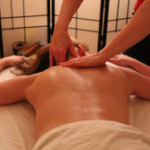 We hear quite often after a session how good a person feels, but where’s the pain? As though massage is meant to be associated with soreness or pain in order to be effective. Some of this is due in part by misinformed therapists, or improperly trained therapists. In any case, there are very specific myths that are common regarding deep tissue massage, and it’s time we set the record straight.
We hear quite often after a session how good a person feels, but where’s the pain? As though massage is meant to be associated with soreness or pain in order to be effective. Some of this is due in part by misinformed therapists, or improperly trained therapists. In any case, there are very specific myths that are common regarding deep tissue massage, and it’s time we set the record straight.
“It’s common to be sore for three or more days afterwards.”
It is common to experience discomfort during certain techniques, and yes, some people will feel the effects for the day and perhaps through to the next day, but if you are in pain, or feel uncomfortably sore, there may be more to the issue than a particularly ‘rough’ massage. A majority of clients who request a deep tissue are already experiencing some level of pain or discomfort; the massage should not amplify this pain.
“Bruising is pretty normal after a session”
‘There are two types of bruises that can occur during a massage session as a result of improper pressure application by the therapist: Subcutaneous, which is just under the skin and Intramuscular, where damage is done to the actual muscle tissue. The discoloration that appears on the skin’s surface is the result of ruptured blood vessels (University of Maryland Medical Center). There are cases where clients may be anemic or have some other medical issue that may cause them to bruise easily and those people should refrain from receiving deep tissue massage treatments. A client should never have bruising as a result of their massage treatment.’ (source: zentoyou.com)
If you’ve bruised after a session, the therapist cause injury, and that’s a problem. It’s not normal to have a bruise after a massage, period.
“It has to hurt in order to work!”
There may be a ‘no pain, no gain’ mentality in other arenas of health, but not in massage. Deep tissue massage doesn’t mean deep pain, it means focusing into the deeper layers of muscle tissue. It’s more in depth, and is best for those in need of pain or stress management. Pain is our body’s way of telling us that something is threatening us; when you touch intense heat, you pull away quickly, or when you are cut, you instantly bring focus to healing in that place. The same goes for massage. If the therapist is causing pain, the anxiety levels within the body go up, the body tightens and the client can no longer feel the positive effects of the massage.
Know the difference between pain release/relief and something causing you pain. Massage is a healing technique, and no, you should not have to work through the pain to feel the healing. Let’s talk about your pain and how we can help manage and heal it without having to deal with the myths of deep tissue massage.